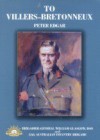To Villers-Bretonneux with Brigadier-General William Glasgow, DSO and the 13th Australian Infantry Brigade
Written by: Peter Edgar,
Australian Military History Publications, NSW, 20061
ISBN: 9781876439460, 284pp.
Reviewed by: Lieutenant Colonel Miles Farmer, OAM (Retd)
Readers interested in the study of the battles on the Western Front in World War I will be familiar with the battle of Villers-Bretonneux on 25 April 1918—said by many to have been the turning point of the war. Be that as it may, it certainly won Brigadier General William Glasgow a well-deserved name for himself. At the outset I will say that this is an excellent book, enlightening, and enjoyable to read, despite the sadness of the casualty lists it includes.
The author, Peter Edgar, examines the ‘work’ of the 13th Australian Infantry Brigade from its formation in Egypt on 16 February 1916 through to its success at Villers-Bretonneux on 24–25 April 1918. He dedicates the book to his great uncle, Private Leslie Edgar of the 50th Battalion, 13th Brigade, who was killed in action at Noreuil on 2 April 1917.
The ‘Anzac legend’ and the varying views of the Australian soldier are considered, debunking many of the opinions of the ‘revisionists’. Without going into detail as to how the war came about, Peter Edgar provides a number of compelling reasons for Australia’s participation—this was not only in Australia’s national interest, but to ‘rid the world of would-be tyrants’.
The problems facing the armies on the Western Front are discussed against the backdrop of Waterloo in 1815, and Gettysburg in 1863, and an outline of the characteristics of the weapons and armaments of the times. Crossing ‘no-man’s land’ was common to all of the battles. The difficulties of applying fire and movement required new tactics which constantly evolved as the First World War progressed. Command and control was an everpresent problem.
To understand something of the qualities and experience of the officers and men who made up the 13th Brigade, Peter Edgar reviews the part played by the 3rd Brigade, the first to land at Anzac Cove. The chapter on the landing at Anzac Cove makes interesting reading, with brief sketches of some of the officers and men who were to make up the nucleus of the 13th Brigade, several later gaining command of its battalions.
Glasgow has a well-deserved chapter to himself. The importance of his training as a part-time soldier, his service in the Boer War and at Gallipoli, paints a picture of the man who formed, trained, and took his men into their first encounter with the Germans in France in August 1916. The 13th Brigade, 4th Division, had been formed from the 3rd Brigade and its battalions as well as a body of new reinforcements.
The brigade trained in Egypt before arriving in Marseilles, France, on 11 June 1916, then moving north to an area west of Messines. Within two months the brigade was engaged in the first attack on Mouquet Farm in August 1916. The author then takes the reader in some detail through the major battles in which the brigade took part—Noreuil, April 1917; Messines, June 1917; Zonnebeke; Dernancourt March–April 1918, and finally Villers-Bretonneux, April 1918. There are also detailed descriptions of many days spent in the trenches holding the line.
At this point it is worthwhile to look at maps in the book. Generally speaking they are good, although, in common with most books of military history, there has to be much turning back of pages to follow the description of a complex operation. Slim’s book, Defeat into Victory, probably has the best placement of fold-out maps, allowing the battles to be followed easily. These days, the cost of printing no doubt prohibits such luxury. The acid test is whether the maps adequately support the action being described: my answer is ‘yes, they do.’
There was usually some time for rest following the battles of World War I, and occasionally time for sport. Reorganisation was essential for the absorbing of reinforcements, and to make good the losses in officers and men. Then came training, and re-training at all levels, and in all aspects of preparing for the next operation. Peter Edgar shows how the brigade, through this attention to detail, retained its integrity and built on lessons learned.
Edgar also shows how Glasgow develops as a leader, with growing confidence in himself and his brigade. Thus he was ready to challenge the army and divisional plan, and timings for the counter-attack on Villers-Bretonneux. He is also shown to be fallible, when he orders a daylight move to fill a gap during the battle. Fortunately he has the good sense to accept the advice of two of his battalion commanders to wait until darkness. It was not long after this that Glasgow was promoted to Major General and given command of the 1st Australian Infantry Division.
In his concluding chapter, Peter Edgar answers the question on the Australian soldier which he posed himself at the beginning of the book—’how effective was he and, if he was effective, how did he become so?’ He demonstrates how the earlier battles, including the landing at Anzac Cove, did not display anything of the control and cooperation of all elements of the brigade demonstrated at Dernancourt and Villers-Bretonneux. The constant training and the actual experience of battle turned the gifted amateurs of 1915 into the seasoned professionals of 1918.
The comprehensive endnotes and extensive bibliography reflect the wide-ranging and depth of research which Peter Edgar has put into his writing. The book is 290 pages long in a well-presented hardback. As I said at the outset, it is an excellent book, enlightening and enjoyable. I commend it, and hope that other readers will find it as interesting as I have.
Endnotes
1 Copies of this book may be obtained through The War Bookshop, tel: (02) 9542 6771; fax (02) 9542 6787; warbookshop@bigpond.com, cost: $45.00 (post free in Australia).\

